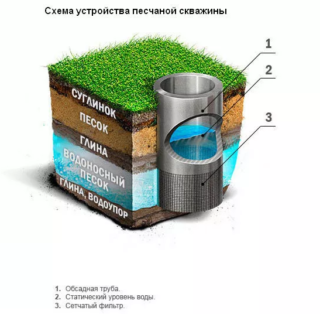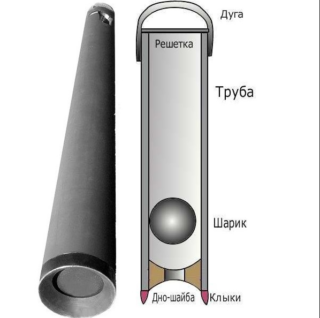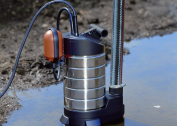Autonomous water supply of a suburban area is primarily a reliable source. One of these is a do-it-yourself sand well. The performance of such a hydraulic structure allows uninterrupted supply of water to a family of three.
The device and characteristics of the well on the sand
 A source drilled on the sand with its own hands consists of the following elements:
A source drilled on the sand with its own hands consists of the following elements:
- Mine (aka casing). Made of steel or plastic pipes. Protects the walls of the drilled well from shedding.
- Coarse filter. Located at the very bottom of the column at the aquifer.
- Submersible or surface pumping equipment.
- Pipes going from the well to the house.
- Headpiece and caisson. Protect the upper part of the source from debris, precipitation. In addition, a hydraulic accumulator and automatic equipment for controlling the pump are installed in the caisson.
Sand Well Specifications:
- the depth of the source is from 15 to 50 meters;
- productivity - 1-1.5 m3 / hour;
- diameter of casing pipes - from 100 mm.
The cross section of the column is selected depending on the productivity of the well. The greater the yield, the wider the diameter.
Advantages and disadvantages
When drilling sand wells, masters highlight the following advantages of sources:
- small depth of hydraulic structures;
- the ability to form a well in 1-2 days;
- no need to use complex dimensional equipment (especially good for small suburban areas);
- lower cost of professional drilling;
- no need to obtain a license for a well (it is necessary for an artesian source).
Of the minuses distinguish:
- instability of water loss of an aquifer;
- low well productivity;
- the risk of not reaching the sandy aquifer due to the geological features of the site;
- short service life (with continuous continuous operation up to 8-10 years).
A sand well is characterized by dubious water quality, especially if production facilities are located near the village. All atmospheric precipitation, sewage, etc. fall into the upper aquifers.
The necessary equipment for drilling
To drill a deep sand well instead of a thin Abyssinian well, you will have to prepare the following equipment:
- Metal auger with sharp edges. They will gently cut the soil when forming the source deep.
- Shovel bayonet.
- Garden cart for soil removal.
- Upsetting pipes with a section smaller than the screw.
- A pump with a hose to swing the source.
- Winch and bailer.
Before performing work on the lowest part of the casing, you need to make holes of 2-3 mm in increments of about 5 cm. Such holes should stretch about 50-70 cm from the bottom of the tube. Then the outer part of the homemade filter is tightened with a fine mesh. This will be a kind of rough cleaning installation.
To start independent drilling, you need to prepare the site. In the proposed location of the well to a depth of 1 m and with dimensions of 1x1 m, a layer of fertile soil is removed. This will insure in the future the well shaft from shedding of soil during drilling.
Drilling process
The formation of the sand source is carried out in one of the most convenient ways for the master - shock-rope, screw or rotary using professional equipment.
Shock Rope Drilling
Use a special driving glass (choke) with a sash in the lower part. They work on this principle:
- On the prepared site set the winch on a tripod.
- A driving glass with sharp lower edges is tied to it.
- Using a standard garden drill, make a primary depression in the ground.
- A bailer is lowered into it with force from a height of 50-80 cm. Under its weight, it will crash into the ground. Upon impact, the glass shutter opens to collect sand and soil. When lifting the baffle, the sash closes, preventing the contents from spilling out.
- With the help of a winch, a driven glass is raised upward, freed from the ground.
Such actions are repeated, gradually deepening into the ground to a sandy aquifer.
Auger drilling
To form the source using a screw. As a result, excavation of the soil and rocks takes place in a spiral. A similar method of drilling is ideal for areas with soft, loose soil. The rotation of the auger is best done by two or even three. As it deepens, it is necessary to grind the auger base pipe using thread or special couplings. To remove the device from the ground after reaching the aquifer, use a winch with an electric motor.
The source formation scheme involves the installation of a casing of metal or polymer.
Professional drilling
Source formation by this method involves the use of professional equipment. Deepening in the soil occurs quickly. In parallel, the craftsmen immediately form the casing.
Which is better - a well on sand or an Abyssinian well
The sand well and the Abyssinian well have a number of features. The Abyssinian well is good because it is drilled very quickly (only 3-5 meters deep), does not require large-scale work and sophisticated equipment - everything is done with a small pipe with a sharp end. Water can be fed up with a thin pipe with a cross section of 25-50 mm. Such a well is also called a needle. The arrangement can be carried out even in the basement of the house.
However, the Abyssinian well is a temporary solution. Water supply from this layer can stop at any time: seasonal lowering of groundwater, wear, depletion of the core. In addition, the higher the horizon, the worse the quality of the water in it. In this regard, a sand single tube well is many times better.
The cost of sand wells for water in the Moscow region starts at 1,000 rubles / meter. The price rises depending on the source parameters, the material of the casing used, the location of the site and the features of the relief.
Owner reviews
Judging by the reviews of the owners about the well on deep sand, such sources are popular.
Alexey, 35 years old. Two years ago, he ordered the drilling of a well from a special team. They made a depth of 45 m on sand. It gives water in the range of 0.4-1 m3 / hour. We have enough for a family home with my wife. Garden watering from a pond nearby. Mineral composition of water is normal. The nitrate readings were slightly off scale, but set the reverse osmosis filter. Everything is fine now.
Sasha, 45 years old. I inherited my well on the sand from the site. Former owners say its depth is 35 meters. Casing from steel pipes. Sand slipped slightly in the water. Put a good coarse filter. It’s been 5 years already. It gives water 1.5 m3 / h. There is enough for a small house. How to behave further, I do not know. But for now, everything is fine. The water supply runs from a station with a 25-liter accumulator.





